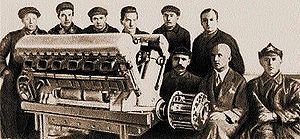Mikulin AM-34
| AM-34 | |
|---|---|
 |
|
| Mikulin M-34, 1932 | |
| Type | Liquid-cooled V12 engine |
| National origin | Soviet Union |
| Manufacturer | |
| Designed by | Alexander Mikulin |
| First run | 1931 |
| Major applications | Tupolev TB-3 |
| Produced | 1934–43 |
| Number built | 10,538 |
| Developed into | Mikulin AM-35 |
The Mikulin AM-34 (M-34) was a Soviet mass-produced, liquid-cooled, aircraft engine. Before the war, the Russian aero engine industry was mainly engaged in producing engines of foreign design, notably Wright, Bristol, Hispano-Suiza, and Gnome-Rhône. Several engines of so-called original design have been developed, although these were probably largely based on foreign models. The M-34 was thought to have been originally designed in Italy by Fiat for the Russians; its design closely follows Italian in-line aero engine practice. Its initial development was troubled, but it eventually became one of the most successful Soviet aircraft engines of the 1930s. It was utilized on the Beriev MBR-2, Tupolev TB-3, Tupolev TB-4, Tupolev ANT-20, Petlyakov Pe-8, Kalinin K-7, Polikarpov I-17, and Bolkhovitinov DB-A aircraft as well as the G-5 and various prototype motor torpedo boats. A version of the maritime model was adapted for use in several prototype heavy tanks in 1939, although none were placed into production.
The M-34 began development in 1928 as a replacement for the Mikulin M-17, a license-built copy of the BMW VI. It had similar dimensions and attachment points, but was otherwise an entirely new design. It was a direct-drive, block-type engine with the cylinder block connected by long internal studs with centrally coupled articulated connecting rods. The development of the engine process was prolonged, with the engineering drawings not completed until April 1931. The first engine was delivered to TsIAM (Tsentralniy Institut Aviatsionnogo Motorostroeniya, Russian: Центральный Институт Авиационного Моторостроения) on 21 September 1931 for bench testing with imported carburetors and magnetos. It began state testing in November 1931, but failed. It was submitted again a year later with Soviet-designed K-34 carburetors, but was again rejected. It was resubmitted in January 1933, but again failed. It was flight-tested in a Tupolev TB-3 in October 1933.
...
Wikipedia
